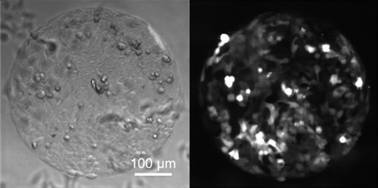Spatial organization of gene expression is a crucial element in the development of complex native tissues, and the capacity to achieve spatially controlled gene expression profiles in a tissue engineering construct is still a considerable challenge. To give tissue engineers the ability to design specific, spatially organized gene expression profiles in an engineered construct, we have investigated the use of microcontact printing to pattern recombinant adeno-associated virus (AAV) vectors on a two dimensional surface as a first proof-of-concept study. AAV is a highly safe, versatile, stable, and easy-to-use gene delivery vector, making it an ideal choice for this application. We tested the suitability of four chemical surfaces (–CH3, –COOH, –NH2, and –OH) to mediate localized substrate-mediated gene delivery. First, polydimethylsiloxane stamps were used to create microscale patterns of various self-assembled monolayers on gold-coated glass substrates. Next, AAV particles carrying genes of interest and human fibronectin (HFN) were immobilized on the patterned substrates, creating a spatially organized arrangement of gene delivery vectors. Immunostaining studies reveal that –CH3 and –NH2 surfaces result in the most successful adsorption of both AAV and HFN. Lastly, HeLa cells were used to analyze viral transduction and spatial localization of gene expression. We find that –CH3, –COOH, and –NH2 surfaces support complete uniform cell coverage with high gene expression. Notably, we observe a synergistic effect between HFN and AAV for substrate-mediated gene delivery. Our flexible platform should allow for the specific patterning of various gene and shRNA cassettes, resulting in spatially defined gene expression profiles that may enable the generation of highly functional tissue.


 Please wait while we load your content...
Please wait while we load your content...